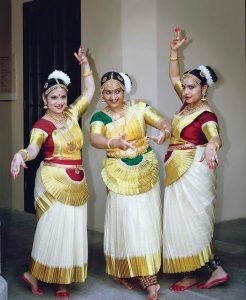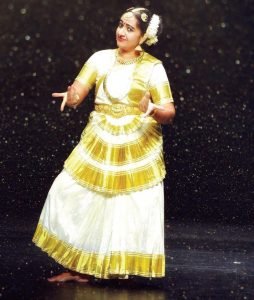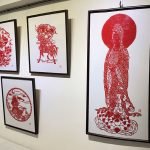
The Rhythmic Enchantment of Mohiniyattam
- bey0ndM@gz!ne
- January 29, 2021
- Culture, Default
- 0 Comments
India is a land of vibrant culture and art, boasting a variety of delectable cuisines, festivals, traditional dance, and music genres. Every state offers their own regional flavours and cultural nuances, especially in the arena of the Arts. This diversity make these art forms unique and distinguishable, and represents a sense of pride within each state.
 Art knows no geographical or cultural barriers. Often enough, we are able to get a glimpse of the highly individualised culture and lifestyle of a particular region/state through their Art form. For example, Madhubani Painting is an ancient art technique promoted by artists in Mithila that uses a variety of tools, including fingers, twigs, brushes, nib-pens, and matchsticks, and natural dyes and pigments. This ancient painting technique, passed down through generations, remains alive to date, championed by families and institutions in Mithila and its neighbouring areas.
Art knows no geographical or cultural barriers. Often enough, we are able to get a glimpse of the highly individualised culture and lifestyle of a particular region/state through their Art form. For example, Madhubani Painting is an ancient art technique promoted by artists in Mithila that uses a variety of tools, including fingers, twigs, brushes, nib-pens, and matchsticks, and natural dyes and pigments. This ancient painting technique, passed down through generations, remains alive to date, championed by families and institutions in Mithila and its neighbouring areas.
In the Indian Classical Performing Arts scene, each classical dance form shares some core principles that are represented through costumes, movement styles, facial expressions, footwork and hand gestures. The beautiful storylines usually feature the life events and occurrences of the Hindu Gods in mythology.
The major Indian classical dance forms recognised by Sangeeta Natak Academy and the Ministry of Culture are: Bharatanatyam, Kathak, Kathakali and Kuchipudi. Recent additions to the list are: Manipuri, Mohiniyattam, Odissi, Sattriya and Chhau.
 Delving deeper into the graceful classical dance form, Mohiniyattam, that showcases gentle body movements and a meditative quality, which has increased its popularity amongst art enthusiasts globally.
Delving deeper into the graceful classical dance form, Mohiniyattam, that showcases gentle body movements and a meditative quality, which has increased its popularity amongst art enthusiasts globally.
Mohiniyattam, also referred to as ‘Mohini Attam’ is the classical dance form of Kerala. The term ‘Mohini’ refers to ‘enchantress’ and ‘Attam’ refers to a rhythmic movement. The name is derived from a storyline in Hindu mythology where Lord Vishnu disguised himself as ‘Mohini’ to acquire ‘Amrit’ (Nectar of Immortality) from the Asuras, in order to give it to the Devas, conveying the ideology of good prevailing over evil.
The dance form originated in Kerala, a southern state in India, known for an abundance of luscious green landscapes, beautiful bodies of water and idyllic temples. Kerala’s astounding natural beauty plays host to its folk, martial and classical dance forms. Kathakali, Kalaripayattu and Koodiyattam are some of the other more well-known dance forms of Kerala, alongside Mohiniyattam.
The ancient temple sculptures are the earliest evidence of Kerala’s traditional dance form, Mohiniyattam, and its origins date back to the 16th century Indian scripture, ‘Vyavahaaramala’, written by Sage Bharata. The dance form entered its growth phase and systematisation during the reign of the Maharaja of Travancore, Sri Swati Thirunal Rama Varma during the 18th century. Maharaja Sri Swati Thirunal Rama Varma was an art connoisseur who promoted and provided structure to the Mohiniyattam format, with the aid of his lyrical and music compositions.
Although, previously identified as a woman-centric dance form, Mohiniyattam is now being widely adopted and beautifully performed by male dancers.
 What makes Mohiniyattam incredibly enchanting?
What makes Mohiniyattam incredibly enchanting?
Mohiniyattam follows the ‘Lasya’ tradition of dance movements, mentioned in the ‘Natya Shastra’, where the dancer’s body moves in a gentle, swaying manner to express or tell a story. Whilst observing a Mohiniyattam dance performance, you can see that the movements are sustained and follow a circular pattern centred around the dancers torso.
Dr. Arpita Chatterjee, Assistant Professor in Molecular Biology, India who conducted a research about the ‘Therapeutic Benefits of Indian Classical Dances’, has noted in an article that Mohiniyattam dancers have stronger muscles in their thighs, the central part of their legs, and ankles. It is believed that this strength is linked with the way they move when dancing.
Another interesting feature of this dance form is its footwork. Mohiniyattam dancers use controlled footwork with no heavy stamping sounds on  the dance floor. The footwork is characterised by gentle taps mostly. Although the movements and the footwork looks gentle, the dancer requires high energy and flexibility, in order to keep in control of the lower body whilst moving the upper body when dancing.
the dance floor. The footwork is characterised by gentle taps mostly. Although the movements and the footwork looks gentle, the dancer requires high energy and flexibility, in order to keep in control of the lower body whilst moving the upper body when dancing.
The storylines are expressed with the support of hand gestures (Hasta Mudra), nine emotions (Nava Rasa) and body movements. Together, these elements help to establish a clear and positive performer-to-audience communication. Mohiniyattam dancers perform with the accompaniment of vocal Carnatic music and instruments such as the Edakka (Hour-glass shaped Drum), Maddalam (Barrel Drum), Kuzhi Thaalam (Cymbals),
Veena (String instrument) and Flute. The lyrics are mostly written in Manipravalam (a combination of Sanskrit, Malayalam and Tamil), and the Raga rendition is based on the Sopanam style, which is a slow melodic music genre. The serene dance form was revived during the 1930s at the Kerala Kalamandalam, University of Arts and Culture, and its evolution continues to present day. The creative freedom and interpretive style of the Mohiniyattam repertoire allows for continued growth and evolution of the art form for generations to come.




